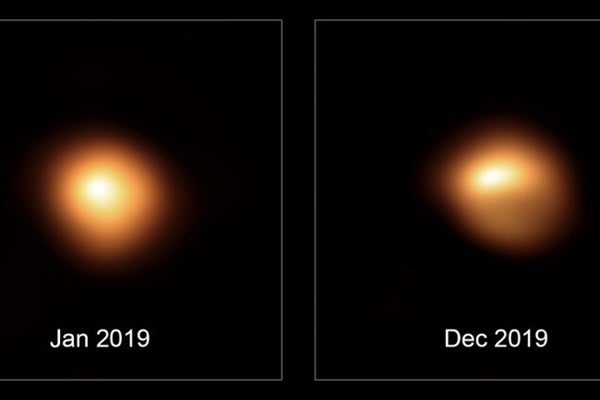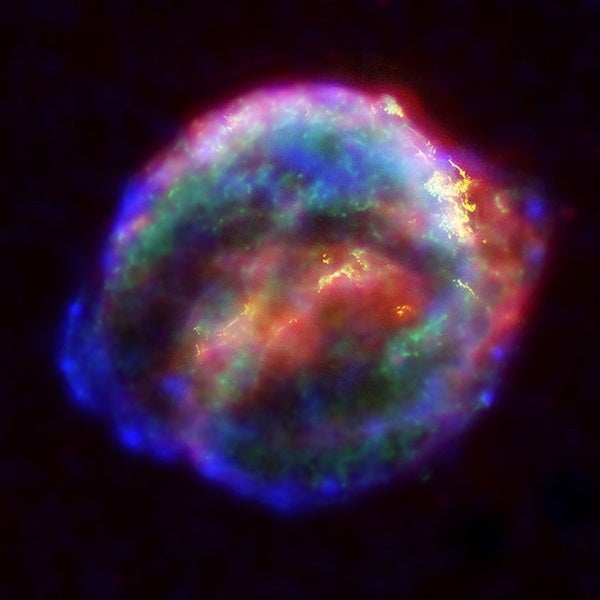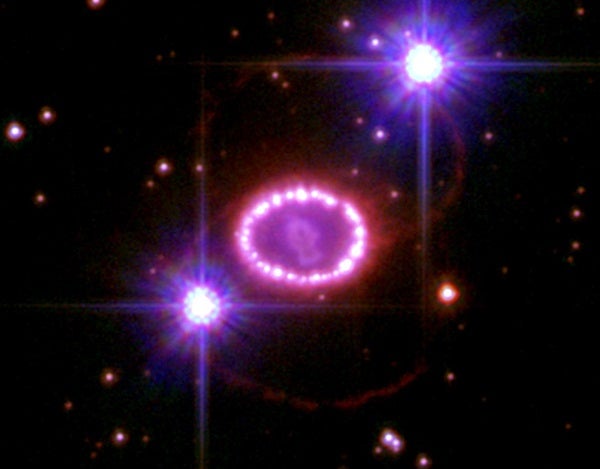Now, new research published August 13 in The Astrophysical Journal outlines the likely cause: the ejection of hot, dense gas which quickly cooled into dust, blocking much of the southern part of Betelgeuse.
Star light, star not so bright
During January 2019, everything with Betelgeuse seemed normal. Then, a short time later, the star began to dim. By February 2020, it was just two-thirds its normal brilliance.
The cause of Betelgeuse’s dip in brightness initially baffled astronomers. But with this new research, they’ve charted a timeline of events leading up to the star’s dramatic dimming. They were able to do this because, beginning in January 2019, the Hubble Space Telescope periodically observed Betelgeuse in the ultraviolet wavelength, revealing new aspects of the stellar monster.
From September to November of 2019, the historic space telescope spotted signs of dense blobs of sizzling material moving through the star’s atmosphere. And by December, ground-based telescopes started to witness the star dimming.
“We think this [ejected] gas cooled down millions of miles outside the star to form the dust that blocked the southern part of the star imaged in January and February,” lead author Andrea Dupree said in a press release.
“Only Hubble gives us this evidence [of what] led up to the dimming,” Dupree added.
Lingering mysteries for Betelgeuse
Although scientists might have solved the case of Betelguese’s dimming, the goliath star isn’t done confusing astronomers just yet.
For one, the mass ejection that caused the dimming didn’t erupt from one of the star’s poles — which is where gravity should be weakest, thus making it easier for material to escape the star’s clutches. “We don’t know how [star’s like this] loose mass,” Dupree tells Astronomy. “Is it a nice wind that just goes out slowly forever or does it come out in puffs and bursts?”
Furthermore, NASA’s Solar Terrestrial Relations Observatory (STEREO) captured additional observations of Betelgeuse, published July 28 in The Astronomer’s Telegram, that showed another, smaller dip in the star’s brightness. And this one occurred nearly a year before Betelgeuse should be reaching a minimum.
“It shouldn’t be doing this,” Dupree says. “[But] maybe it’s going to be a little bump.” With consistent observations of the star dating back 150 years, it isn’t unusual for Betelgeuse to start getting faint and quickly brighten back up. Nonetheless, Dupree plans to observe Betelgeuse again through August and September, during the star’s expected maximum, to monitor for more unexpected outbursts.
Will Betelgeuse go supernova soon?
Unlike our Sun, which is a main-sequence star, Betelgeuse is a red supergiant and has a radius approximately 900 times that of the Sun. So, if the Sun were replaced with Betelgeuse, the star’s surface would breach the orbit of Jupiter.
Betelgeuse is also approaching the end of its life. Within the next 100,000 years, the star is expected to go supernova, and scientists and amateur astronomers alike are eager to watch the dramatic event unfold. When the supergiant finally does blow, the explosion will be as bright as the Full Moon and will remain visible during the daytime for months.
While supernovae are relatively common in the universe — the sheer size of the cosmos means that scientists witness the death of a star every few days — to spot one from your own backyard still requires a bit of luck. Astronomers estimate that galaxies like the Milky Way should host a supernova about once every 50 years or so. However, the last major supernova nearby, SN 1987A, occurred in the Large Magellanic Cloud, which is a satellite galaxy of our own. (Recently, astronomers discovered a hot ‘blob’ of material within SN 1987A the think proves SN 1987A still harbors a neutron star.)
At around 700 light-years away, the light we see today from Betelgeuse first departed the star’s surface in the 1300s — so, it’s entirely possible that the giant has already gone supernova. And if that’s the case, we just have to patiently wait for the show to finally reach us.













